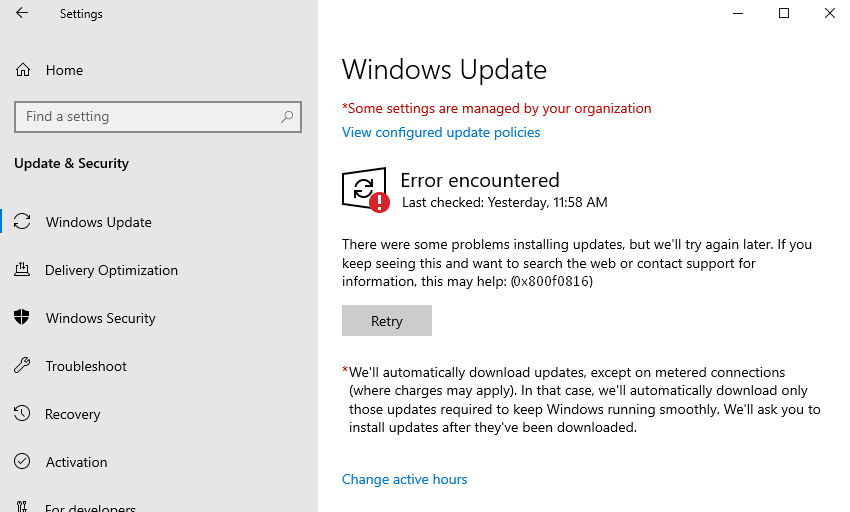Are you unable to download and install a patch or build in the Windows 10 and 11 system and encountering certain error code? 0x800f0816 is one such issue that appears because Windows update files conflict with some of the existing apps and result in sudden failure. Further, the OS hints to reboot itself moreover triggers a system restore while doing so. Once the computer powers up, status 0x800f0816 error can be seen in the Windows update history.
Windows update error 0x800f0816 commonly occurs because of obsolete system files furthermore a bug that can also turn up due to a malfunctioning software program that you recently installed. In most cases, built-in troubleshooters of Windows update settle down the error code but if not you might need to try out some other ways too. We have listed all possible resolutions to fix the update error; go through the method lists for quick navigation –
Table of Contents
Update error code 0x800f0816 on Windows 11 and 10 PC
Here is how to fix Update error code 0x800f0816 on Windows 11/10 PC –
1] Use Windows Update Troubleshooter
To solve any update errors, the easiest at the same time effective thing to do is making use of built-in troubleshooter that Windows offers. The utility diagnoses the problem and resolves the issue that was causing status 0x800f0816 error. To run Windows update troubleshooter –
In Windows 10
- Press Win+I hotkey together.
- Click the Update & Security.
- Choose Troubleshoot from the left column.
- Move to the right.
- Click the link Additional troubleshooters.
- Look for Windows Update and select the same.
- Click the Run the troubleshooter.

- Apply the potential fixes the troubleshooter comes up with.
- Close the troubleshooter and check for the update error.
For Windows 11
- Right-click Start button and choose – Settings.
- Move to the right of Settings page.
- Scroll down a bit and choose – Troubleshoot.
- Click – Other troubleshooters.
- From the next page, Hit Run present next to Windows update.
2] Purge Windows update components
Windows update is one of the significant components of Windows as it is in charge of managing everything associated with the upgrading process. Anything wrong with the same can generate error 0x800f0816. There might be various reasons to make the update component corrupted as it’s a software program after all.
Purging the same will restore the default settings of that component moreover help the system to resolve the related issue. Here is how to proceed –
- Press Windows key and S at one go.
- Type in cmd.
- Select the Run as administrator when the search result appears.
- Click Yes for the UAC.
- Put these following commands one after another and hit Enter after each line –
net stop wuauserv
net stop cryptSvc
net stop bits
net stop msiserver
- In the same black panel, execute below command lines one by one –
ren C:WindowsSoftwareDistribution SoftwareDistribution.old
ren C:WindowsSystem32catroot2 Catroot2.old
- To start the update component again, run the following lines –
net start wuauserv
net start cryptSvc
net start bits
net start msiserver
3] Check if the Windows Firewall is working fine
Windows PCs with Firewall disabled are more likely to generate status 0x800f0816 error. So, it’s necessary to check if the utility is turned on or working perfectly. To do so –
- Right-click on the Start icon and choose Run.
- Type control in the command box and hit Enter key.
- Set the View by option to Large icons.
- Opt for Windows Defender Firewall.
- Ensure that there are no red highlights in the right pane and everything is green.
- If the feature is disabled, click Turn Windows Firewall on or off from left column.
- Select the radio button set aside Turn on Windows Defender Firewall.
- Do same for both Private network settings and Public network settings.
- In the end, click OK.
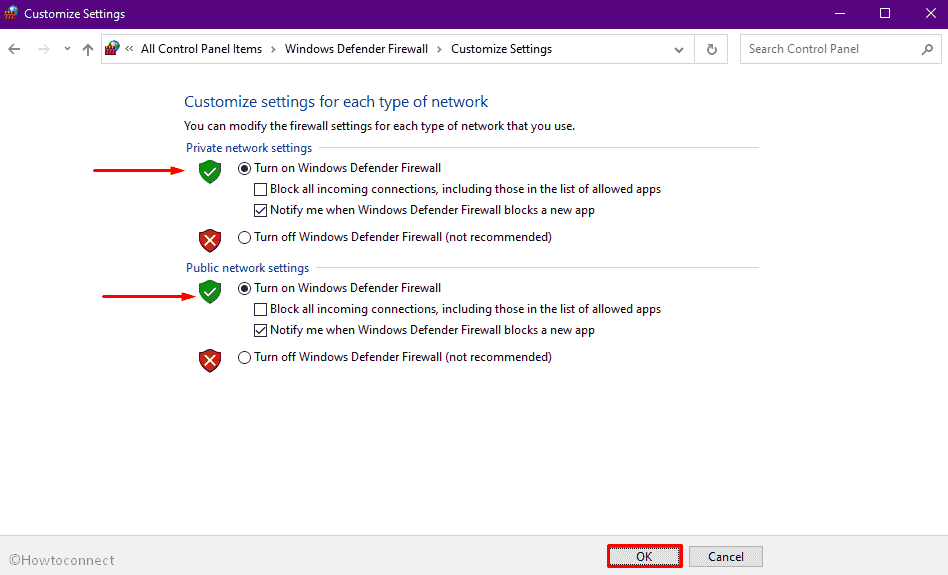
4] Reset BITS to fix Update error code 0x800f0816
BITS is another important component that helps the updating process to a great extent. If the service gets disabled somehow, 0x800f0816 may show up while downloading or installing a new patch.
- Press the Win+R keyboard shortcut.
- Put in services.msc in the dialog box.
- Click the OK.
- Scroll down to find Background Intelligent Transfer Service.
- Right-click the same and choose Restart.
- Wait for the process to restart.
- Thereafter, again right-click on Background Intelligent Transfer Service.
- This time, choose Properties.
- Set the Startup type to Automatic.

- Click Apply followed by OK to save the modifications.
5] Remove Windows Update download path
Status 0x800f0816 error often goes away after deleting the associated string value data using the Registry editor. Be confident enough to do this task as anything wrong with Regedit may end up causing some other issue. However, the procedure is not hard at all if you follow the below procedure precisely.
- Click the search icon from the taskbar.
- Type in regedit and hit Enter key.
- Click Yes when a UAC prompts.
- Navigate the following path once in the Registry Editor –
HKEY_LOCAL_MACHINE\SOFTWARE\Policies\Microsoft\Windows\WindowsUpdate
- Look for “WUServer” and “WIStatusServer” (obviously without quotes) in the right-hand pane.
- Right-click on any and select Delete. Remove both in this way.
- Restart Windows.
6] Clean boot Windows to get rid of Update error 0x800f0816
This procedure lets the system boot with a minimal set of drivers at the same time startup programs and services. 0x800f0816 will disappear once you clean boot the OS only if the issue was caused by a third-party component. Here are the steps you need to follow –
- Open Run dialog box.
- Put in msconfig and click OK.
- Click the radio button set before Selective startup.
- Once the grayed options become active, uncheck the box lying alongside Load startup items.
- Head over to Services tab.
- Tick the box against Hide all Microsoft services.
- Click the Disable all from same wizard.
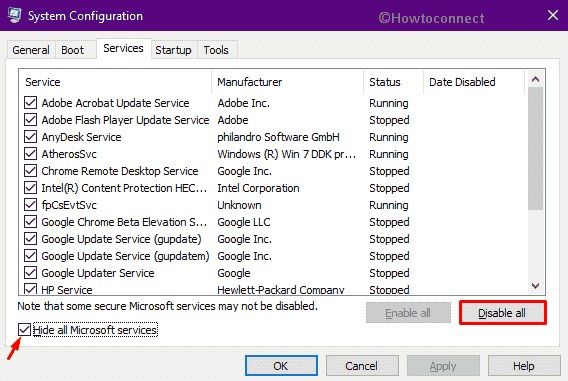
- Shift to Startup tab.
- Select the link Open Task Manager.
- Doing so will bring Task Manager with Startup tab opened.
- Right-click on each program one at a time and chooses Disable for all.
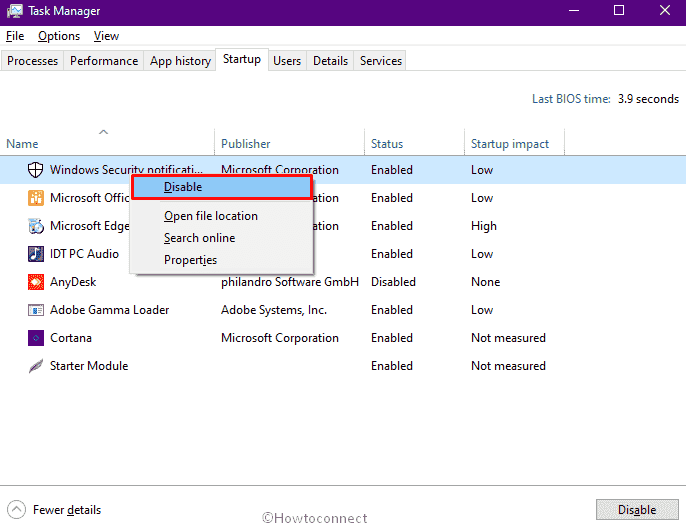
- Close Task Manager and go back to the System Configuration wizard.
- Click on Apply and then OK.
7] Uninstall previously installed updates
Update Error 0x800f0816 occurred recently on Windows 10 and some of the Windows 11 versions. This may be an outcome of the bug carried through a previous or recent update or patch. So, uninstall it if you have received the same using following instructions –
- Press – Windows + R.
- Insert – appwiz.cpl.
- Click – OK.
- When a new window appears, select – View installed updates from left sidebar.
- Go through the list to reach Microsoft Windows.
- Right-click on the patch you received last and choose Uninstall.
- Click Uninstall once more if a pop-up appears for the final confirmation.
- Comply with the on-screen guidelines to complete the process.
- Upon completion, reboot Windows and try to get the new update.
8] Delete Temp Files for System along with User related %temp% files
Whenever you perform a task, the OS creates temporary files for each execution. There is no use of such items and they occupy noticeable disk space that keeps increasing with time. Due to low disk space, often the system fails to update or install new patches and give rise to error codes like Status 0x800f0816. Removing the temp file will not only make some free space but fix the issue.
Wipeout temp file for system
- Press the Win+X at once.
- Choose Run.
- Write in temp in the dialog box and hit Enter.
- Press Ctrl+A to select all available items that exist in the Temp folder.
- Hit Delete icon from top bar.
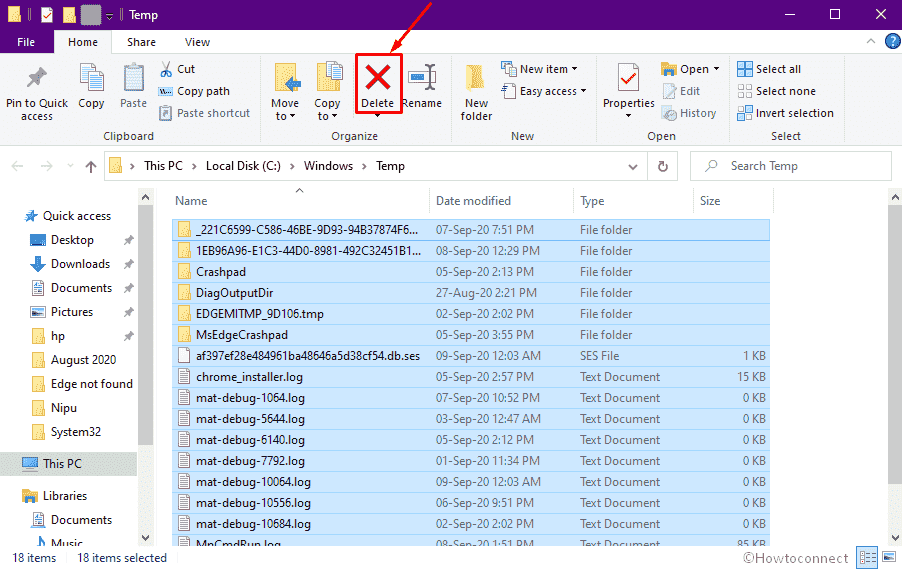
- If a dialog box appears, check the box set before Do this for all current items and then click Continue.
- The same prompt may become visible again. You need to do the same for it too.
Remove User related %temp% files
- Launch the Run command and insert %temp% in it.
- Click OK button.
- When a folder opens up, select all files present here.
- Delete the items in the same way shown above.
9] Reset Internet Explorer Settings
Sometimes, add-ons from unreliable vendor or incorrectly modified security settings of Internet Explorer cause Windows Update error 0x800f0816 to occur. If this happens with you, resetting the same will be effective as it will put the add-ons out of action moreover restore default security, privacy, and other settings.
This procedure will clear all your passwords you did save till now, however, bookmarks will be still there. Here are the steps you need to follow to reset internet options settings –
- Open Control Panel.
- Make sure its View by type is either Large icons or Small icons.
- Click on Internet Options.
- Shift to Advanced tab of newly appeared wizard.
- Click Reset button from the bottom.
- Check the box set for Delete personal settings.
- Hit the Reset.
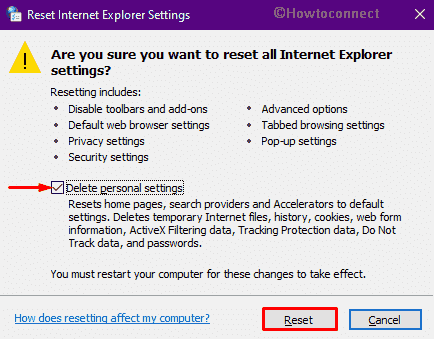
- After completion, close the wizard.
10] Manually download and install the latest Windows KB update to avoid error 0x800f0816
Microsoft usually provides Windows patches automatically once the patches become ready. According to some users, status 0x800f0816 error appears when the process is about to happen automatically. After attempting to download the new patches manually, the fatal code went away. So, trying this trick can be efficient for you too. Follow the steps –
For Windows 10
- Open Windows Settings app.
- Click Update & Security.
- Move to the right pane of Windows update page.
- Hit the button check for updates.
- If any new patch is available, click Download to initiate the process.
- The installation procedure will take place automatically, still, you should stay in front of the PC to perform a manual restart.
For Windows 11
- Press – Windows + I.
- Select – Windows Update from left.
- Move to right and then click – Check for updates.
- 11] Run DISM followed by SFC to get rid of system corruption
Corrupt system components are one of the biggest reasons to give rise to update error. There is no exception with Windows Update error 0x800f0816. In such a case, running DISM tool is helpful as it works to find out the underlying cause and fix them mostly.
If it doesn’t, you might need to execute System File Checker in elevated Command Prompt in order to resolve as well as recover faulty core components. Here are the steps to follow –
- Press Win+S and type in cmd.exe.
- Press Ctrl+Shift+Enter altogether.
- When a UAC rolls out, click Yes.
- In the black panel, insert the below command line and hit Enter key –
DISM.exe /Online /Cleanup-image /Restorehealth
- Once the process is finished, reboot your PC.
- After signing back in, check for status 0x800f0816 error.
- If it still persists, again open Command Prompt as admin.
- This time, run the below command –
Sfc /scannow
- As the process is lengthy, wait patiently.
- After completion, restart the PC and check for the update error code.
12] Disable antivirus program for a while to fix 0x800f0816 error
Though Windows 10 and 11 comes with a built-in anti-malware program that holds all modern features to ensure your security, oftentimes you end up downloading third-party one. As a result, they conflict with each other and stops functioning as it should be which may cause damage to system files. When system files go missing or become corrupted, you will conflict several fatal codes.
Also, there might be an instance when the antimalware program you are using misinterpret the update file as a threat and block it from downloading. Therefore, disable the software program for some time and check if it helps.
- Right-click on the antivirus icon from system tray. If it’s not there, click the up arrow icon to get the same.
- Choose Disable or the one that has the same meaning.
- Pick a time slot you prefer after which the app will be enabled automatically.
13] Clean up unwanted System files to free up space
Due to lack of enough disk space, Windows update may get disrupt sometimes and throw status 0x800f0816 error. To get rid of such fatal codes, free up disk space by clearing out all junks that you hardly need. The built-in Disk cleanup tool is best suited to serve this purpose. Steps are as followed –
- Press the Win+S.
- Type cleanmgr in the search bar and hit Enter.
- Click OK for the appearing pop-up where C: is preset.
- Now the tool will calculate how much space it can free up and then present Disk Cleanup for (C:).
- Hit the Clean up system files present in the bottom left corner.
- Click OK for the upcoming pop-up.
- Once the final calculation finishes, Disk Cleanup for (C:) will rise up again.
- Put tick mark in each box available under Files to delete segment. If some essential files and folders exist in Downloads and Recycle bin, leave them unchecked.
- Click the OK button to begin the procedure.
- Hit the Delete files option when a pop-up prompts for the final confirmation.
14] Use System Restore Point to eradicate Windows Update error 0x800f0816
If some recent changes are giving rise to Windows Update error 0x800f0816, System Restore will be more suitable as the tool lets the system loads back error-free image copy of system components. Once the recent changes you made recently get deleted, the update error code will go away possibly. Let’s give it a try –
- Press Windows+X together.
- Choose Run.
- Type rstrui and then hit Enter key.
- When the System Restore wizard comes appears, click Next from the bottom to proceed.
- Click the box set alongside Show more restore points.
- Opt for the most recent Restore point the system made.
- Click the Next.
- Hit Finish button to begin the restoring process.
- A warning message will come up for final consent, click Yes to approve.
- After completion of restoring, the system will reboot itself.
- When a new session starts, you will see a message that confirms that System restore was successful.
15] Clean install the Windows
If nothing from the above helped to eradicate Windows Update error 0x800f0816, the last thing you can do is clean install. This way, you will get a fresh Windows OS that holds no cache and damaged files. Here is how to proceed –
- Navigate the official Software Download webpage of Microsoft.
- Click Download tool now.
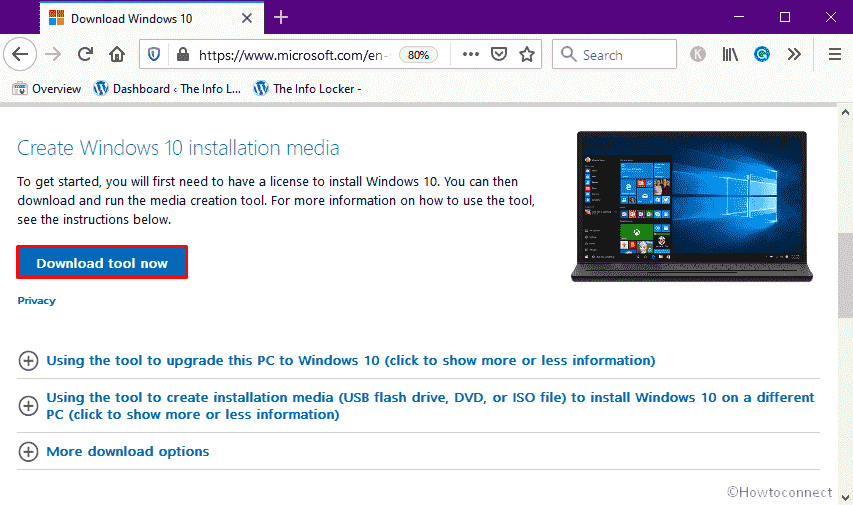
- Hit the Save now.
- Go to the directory where the system saves downloaded files.
- Double-click the item you just got.
- When a User Account Control shows up, click Yes.
- Hit Accept once Windows setup wizard turns up.
- Click the radio button set beside Upgrade this PC now and then hit Next.

- Choose the option Keep your files and apps.
- After that, click Next.
- Finally, hit the Install to initiate the process.
- Follow further instructions that come on screen to finish the procedure completely.
- After completion of download and installation, go to Windows update settings page.
- Click Check for updates from the right pane.
- Hopefully, error 0x800f0816 in Windows 11 and 10 will not appear anymore.
Methods:
1] Use Windows Update Troubleshooter
2] Purge Windows update components
3] Check if the Windows Firewall is working fine
4] Reset BITS
5] Remove Windows Update download path
6] Clean boot Windows
7] Uninstall previously installed updates
8] Delete Temp Files for System along with User related %temp% files
9] Reset Internet Explorer Settings
10] Manually download and install the latest KB update
11] Use DISM followed by SFC to get rid of system corruption
12] Disable antivirus program for a while
13] Clean up unwanted System files to free up space
14] Use System Restore Point
15] Clean install the Windows
That’s all!!
